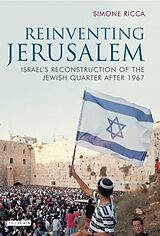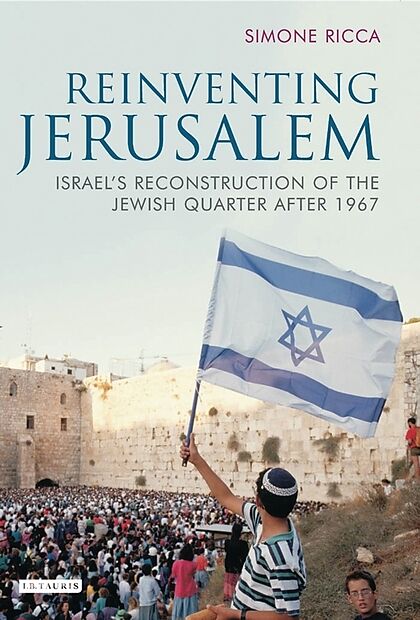Reinventing Jerusalem
Einband:
Fester Einband
EAN:
9781845113872
Untertitel:
Israel's Reconstruction of the Jewish Quarter After 1967
Genre:
Geschichte
Autor:
Simone Ricca
Herausgeber:
Bloomsbury Publishing PLC
Anzahl Seiten:
272
Erscheinungsdatum:
25.05.2007
ISBN:
978-1-84511-387-2
Informationen zum Autor Simone Ricca is an architect who has worked throughout the Middle East on UNESCO heritage and reconstruction projects. He has a PhD in Middle Eastern Studies from the University of Exeter Klappentext The Jewish quarter of Jerusalem today seems like an organic fusion of a modern Israeli city with an ancient Jewish heritage. However, as Simone Ricca details in this fascinating book, the aesthetics of the Jewish Quarter were deliberately planned and executed by Israel after it was occupied during the 1967 war. Secular-nationalist as well as religious politicians agreed that it should be turned in to the capital of the Jewish nation, and that it should be excavated and developed in such a way as to create a sense of continuity with the Jewish people's historical claims to the land. Zionist ideology was thus translated in to bricks and mortar as modern civic amenities were constructed around historic sites, such as the Wailing Wall and the Hurva Synagogue. Ricca examines the politics of heritage conservation, and shows that the Old City's reconstruction did not so much preserve the past as inscribe an identity on to the future. Zusammenfassung The Jewish quarter of Jerusalem seems like an organic fusion of a modern Israeli city with an ancient Jewish heritage. This book details the aesthetics of the Jewish Quarter, how they were deliberately planned and executed by Israel after it was occupied during the 1967 war. It also examines the politics of the heritage conservation. Inhaltsverzeichnis Preface, p. 2; Introduction, p. 5; Historic Context, p. 20; 1. Planning, Nationalism, Heritage and the Jewish Quarter Reconstruction, p. 34; Zionism, the City and Jerusalem, p. 35; Urban Planning and the Creation of the Jewish Capital, p. 39; Heritage, History and Ideology, p. 44; The New Symbolic Meaning of the 'Restored' Jewish Quarter, p. 48; Conclusion, p. 55; 2. Creating the Jewish Quarter, p. 61; The Legal Framework and the Land Confiscation, p. 62; Israeli Architecture, from Prefabrication to Restoration, p. 71; Israeli Archaeology: an Overview, p. 76; The Jewish Quarter Archaeological Excavations, p. 81; Conclusion, p. 85; 3. Building the Jewish Quarter, p. 92; Guidelines for Reconstruction, p. 93; Analysis of the Urban and Architectural Plans, p. 102; Economical and Social Analysis, p. 111; Conclusion, p. 122; 4. Building the Jewish Quarter: Case Studies, p. 130; Selection of the Case Studies, p. 131; The Hurva Synagogue Restoration, p. 134; The Wailing Wall Area, p. 143; The Cardo Project, p. 148; Conclusion: What's in a name?, p. 155; 5. UNESCO and Jerusalem, p. 160; Introduction, p. 161; The Legal System for the Protection of Cultural Heritage, p. 163; Cultural Heritage, UNESCO Politics and the Case of Jerusalem, p. 168; The Urban Transformations: Technical Data (from the Official Reports), p. 172; Lemaire's Reports and UNESCO Policy for Jerusalem: an Interpretation, p. 181; Conclusion, p. 188; 6. Urban Restoration and Ideology in the Middle East:; A Comparative Approach, p. 196; Introduction: Criteria for the Comparison, p. 197; The Fate of the Jewish Quarters in the Arab World, p. 202; Urban Restoration and Arab Heritage in Israel, p. 212; Urban Conservation in Palestinian National Authority's cities, p. 225; Conclusion: The Role of Ideology, Similarities and Differences, p. 244; Conclusion, p. 256; Bibliography, p. 265....
Autorentext
Simone Ricca is an architect who has worked throughout the Middle East on UNESCO heritage and reconstruction projects. He has a PhD in Middle Eastern Studies from the University of Exeter
Klappentext
The Jewish quarter of Jerusalem today seems like an organic fusion of a modern Israeli city with an ancient Jewish heritage. However, as Simone Ricca details in this fascinating book, the aesthetics of the Jewish Quarter were deliberately planned and executed by Israel after it was occupied during the 1967 war. Secular-nationalist as well as religious politicians agreed that it should be turned in to the capital of the Jewish nation, and that it should be excavated and developed in such a way as to create a sense of continuity with the Jewish people's historical claims to the land. Zionist ideology was thus translated in to bricks and mortar as modern civic amenities were constructed around historic sites, such as the Wailing Wall and the Hurva Synagogue. Ricca examines the politics of heritage conservation, and shows that the Old City's reconstruction did not so much preserve the past as inscribe an identity on to the future.
Zusammenfassung
The Jewish quarter of Jerusalem seems like an organic fusion of a modern Israeli city with an ancient Jewish heritage. This book details the aesthetics of the Jewish Quarter, how they were deliberately planned and executed by Israel after it was occupied during the 1967 war. It also examines the politics of the heritage conservation.
Inhalt
Preface, p. 2; Introduction, p. 5; Historic Context, p. 20; 1. Planning, Nationalism, Heritage and the Jewish Quarter Reconstruction, p. 34; Zionism, the City and Jerusalem, p. 35; Urban Planning and the Creation of the Jewish Capital, p. 39; Heritage, History and Ideology, p. 44; The New Symbolic Meaning of the 'Restored' Jewish Quarter, p. 48; Conclusion, p. 55; 2. Creating the Jewish Quarter, p. 61; The Legal Framework and the Land Confiscation, p. 62; Israeli Architecture, from Prefabrication to Restoration, p. 71; Israeli Archaeology: an Overview, p. 76; The Jewish Quarter Archaeological Excavations, p. 81; Conclusion, p. 85; 3. Building the Jewish Quarter, p. 92; Guidelines for Reconstruction, p. 93; Analysis of the Urban and Architectural Plans, p. 102; Economical and Social Analysis, p. 111; Conclusion, p. 122; 4. Building the Jewish Quarter: Case Studies, p. 130; Selection of the Case Studies, p. 131; The Hurva Synagogue Restoration, p. 134; The Wailing Wall Area, p. 143; The Cardo Project, p. 148; Conclusion: What's in a name?, p. 155; 5. UNESCO and Jerusalem, p. 160; Introduction, p. 161; The Legal System for the Protection of Cultural Heritage, p. 163; Cultural Heritage, UNESCO Politics and the Case of Jerusalem, p. 168; The Urban Transformations: Technical Data (from the Official Reports), p. 172; Lemaire's Reports and UNESCO Policy for Jerusalem: an Interpretation, p. 181; Conclusion, p. 188; 6. Urban Restoration and Ideology in the Middle East:; A Comparative Approach, p. 196; Introduction: Criteria for the Comparison, p. 197; The Fate of the Jewish Quarters in the Arab World, p. 202; Urban Restoration and Arab Heritage in Israel, p. 212; Urban Conservation in Palestinian National Authority's cities, p. 225; Conclusion: The Role of Ideology, Similarities and Differences, p. 244; Conclusion, p. 256; Bibliography, p. 265.

Leider konnten wir für diesen Artikel keine Preise ermitteln ...
billigbuch.ch sucht jetzt für Sie die besten Angebote ...
Die aktuellen Verkaufspreise von 5 Onlineshops werden in Realtime abgefragt.
Sie können das gewünschte Produkt anschliessend direkt beim Anbieter Ihrer Wahl bestellen.
Loading...
Die aktuellen Verkaufspreise von 5 Onlineshops werden in Realtime abgefragt.
Sie können das gewünschte Produkt anschliessend direkt beim Anbieter Ihrer Wahl bestellen.
| # | Onlineshop | Preis CHF | Versand CHF | Total CHF | ||
|---|---|---|---|---|---|---|
| 1 | Seller | 0.00 | 0.00 | 0.00 |
